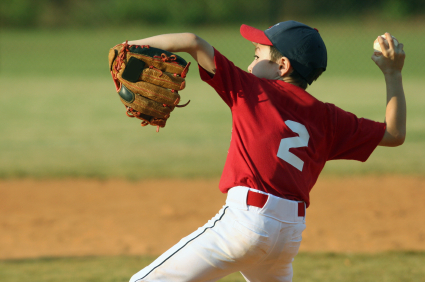A physical therapist offers some tips on chronic shoulder pain
This was on a site called momsteam.com. Concerning shoulder problems, the therapist offers some good tips for strengthening however, since the a dysfunctional core is often at work behind the scenes in any chronic shoulder problem, it should be considered when you have shoulder pain. With any shoulder problem, we should look at not just the part, but the patient the part is attached to.
Chronic Shoulder Pain: A Matter of Anatomy?
Shoulder injuries and pain are common in a variety of sports. Whether it is in throwing a pass in football or a pitch in baseball, athletes need tremendous shoulder strength and coordination to achieve athletic excellence. But the constant strain and pressure on the shoulder often leads to irritation and can result in an overuse injury.
 As a physical therapist, I am often asked why some athletes seem more prone to shoulder injuries than others, how shoulder injuries are treated when they occur, and how can the risk of injury or re-injury be reduced? To answer these questions, we need to start with a discussion of the anatomy of the shoulder.
As a physical therapist, I am often asked why some athletes seem more prone to shoulder injuries than others, how shoulder injuries are treated when they occur, and how can the risk of injury or re-injury be reduced? To answer these questions, we need to start with a discussion of the anatomy of the shoulder.
Shoulder anatomy can effect risk
While the basic structure of the shoulder is the same for every athlete, there are important differences between athletes. First, the shoulder joint is inherently a very unstable joint. The ligaments around the shoulder joint are supposed to hold it in place and provide stability. When those ligaments are loose (what we PTs call “lax”), the joint requires more muscle strength to maintain support, so if those muscles aren’t strong, the risk of injury increases.
Second, other structures around the shoulder joint can increase the risk of injury. A young athlete with scoliosis, congenitally weak neck muscles or spinal vertebra, or poor (e.g. flexed or bent) spinal posture will have trouble keeping the shoulder joint stable. While these deficiencies can be corrected to an extent through training, such underlying conditions will cause the athlete to work harder to maintain balance in the shoulder.
Finally, the shape of the acromion – a hook shaped bone that sits off the rotator cuff – can effect stability: some have a shape that permits increased clearance in the shoulder joint while others are hooked-shaped, increasing the risk for pinching or tearing on the rotator cuff.
Injury history: past as prologue
As with any joint, previous injury is one of the strongest indicators for future injury.
- Compromise to the ligamentous integrity of the shoulder joint, such as a labral tear, increases instability in the shoulder joint, which causes muscles around the shoulder joint to work harder to maintain stability.
- Rotator cuff injuries, including chronic strains and tears, affect shoulder timing and overall joint stamina with overhead activities.
- Weakened rotator cuff muscles make “steering” the shoulder difficult, sometimes resulting in significant damage to the joint and surrounding soft tissue.
Sport affects injury risk
Repetitive overhead motions put the shoulder at greater risk for injury. Baseball, softball, tennis, swimming, and volleyball are a few examples of sports involving repetitive overhead motions. Athletes who sustain repeated hits to the upper body, such as in football and wrestling, are also at increased risk of traumatic injury to the shoulder joint. The fact that the majority of injuries to the shoulder joint result from repetitive motion, regardless of sport, suggests there are ways to avoid serious injury.
Read more: http://www.momsteam.com/chronic-shoulder-pain-may-be-a-matter-of-anatomy#ixzz2RIHdcNHP